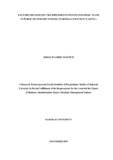FACTORS INFLUENCING THE IMPLEMENTATION OF STRATEGIC PLANS IN PUBLIC SECONDARY SCHOOLS IN RONGAI SUB-COUNTY, KENYA
Abstract
Past research has shown that even though excellent strategic plans have been written in public secondary schools, few have been successfully implemented. Crafting the best strategic plan is not the end in itself. Final results can only be realized once the plan has been successfully implemented. It is a lot easier to craft strategic plans than it is to implement them. While several studies have underscored the fact that there are challenges regarding strategic plan implementation in secondary schools in Kenya, it is important to observe that the implementation matrix varies with context and as such their findings are not necessarily generalizable. Further, few studies have done an in-depth analysis of the key variables identified in the present study. Therefore, this research investigated factors that influence the implementation of strategic plans in public secondary schools in Rongai sub-county. The objectives of the study were as follows: to investigate the influence of leadership, government policy, resource allocation and organizational structure in the implementation of strategic plans in public secondary schools in Rongai sub-county. Private secondary schools were excluded from the study because it is a ministerial requirement for public secondary schools to have strategic plans but not private schools. The study was guided by Mintzberg‟s Model and the Resource Dependence theory. The research adopted a descriptive survey design and targeted 9 out of the 46 public secondary schools in Rongai Sub-County from which a sample size of 112 respondents comprising principals, the deputy principals, heads of departments and teachers was drawn using both purposive and simple random sampling. The non-teaching staff was excluded from the study because, in most schools, they are few and not employed on long term contracts and were therefore not generally involved in the school strategy development. Data was collected through pre-tested structured questionnaires. The questionnaires were pretested for content validity and also internal consistency for reliability. The reliability coefficient for the entire questionnaire was 0.8772 which was above the recommended Cronbach value of 0.7. Data was analysed using descriptive statistical analysis, which was done using frequencies and percentages to describe the basic characteristics of the data. Inferential data analysis was done using Pearson‟s Product-Moment Correlation Coefficient and multiple linear regression. The findings revealed that Government Policies (β = 0.451, p < 0.05) followed by Resource Allocation (β = 0.309, p < 0.05) and Leadership (β = 0.199, p < 0.05) respectively significantly influenced the implementation of strategic plans in the schools. However, Organization Structure was not found to be significant in the model (β = -0.144, p = 0.183 ˃ p = 0.05). Therefore, the study recommends that the training for key stakeholders responsible for the implementation of the strategic plans in the schools be carried out and besides, the study also recommends that the schools' leadership improve their communication and stakeholder involvement practices right from the formulation of the strategic plans to the implementation phase in order to have a good rapport with all involved. Other recommendations are that the schools develop strategies for acquiring resources to finance their strategic plans such as income-generating units and also raising funds and equipment from well-wishers such as NGOs and other charitable organizations. Finally, the study recommends that the government review its policies on strategic planning in schools that can enable it to intervene appropriately in the actualization of the strategic plans.

